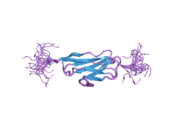- OBSCN
-
Obscurin is a protein that in humans is encoded by the OBSCN gene.[1][2][3]
The obscurin gene spans more than 150 kb, contains over 80 exons and encodes a protein of approximately 720 kDa. The encoded protein contains 68 Ig domains, 2 fibronectin domains, 1 calcium/calmodulin-binding domain, 1 RhoGEF domain with an associated PH domain, and 2 serine-threonine kinase domains. This protein belongs to the family of giant sacromeric signaling proteins that includes titin and nebulin, and may have a role in the organization of myofibrils during assembly and may mediate interactions between the sarcoplasmic reticulum and myofibrils. While several transcript variants likely exist for this gene, the full-length nature of only one has been described to date.[3]
Interactions
OBSCN has been shown to interact with Titin[1] and ANK1.[4]
References
- ^ a b Young P, Ehler E, Gautel M (Jul 2001). "Obscurin, a giant sarcomeric Rho guanine nucleotide exchange factor protein involved in sarcomere assembly". J Cell Biol 154 (1): 123–36. doi:10.1083/jcb.200102110. PMC 2196875. PMID 11448995. http://www.pubmedcentral.nih.gov/articlerender.fcgi?tool=pmcentrez&artid=2196875.
- ^ Russell MW, Raeker MO, Korytkowski KA, Sonneman KJ (Jan 2002). "Identification, tissue expression and chromosomal localization of human Obscurin-MLCK, a member of the titin and Dbl families of myosin light chain kinases". Gene 282 (1–2): 237–46. doi:10.1016/S0378-1119(01)00795-8. PMID 11814696.
- ^ a b "Entrez Gene: OBSCN obscurin, cytoskeletal calmodulin and titin-interacting RhoGEF". http://www.ncbi.nlm.nih.gov/sites/entrez?Db=gene&Cmd=ShowDetailView&TermToSearch=84033.
- ^ Kontrogianni-Konstantopoulos, Aikaterini; Jones Ellene M, Van Rossum Damian B, Bloch Robert J (Mar. 2003). "Obscurin is a ligand for small ankyrin 1 in skeletal muscle". Mol. Biol. Cell (United States) 14 (3): 1138–48. doi:10.1091/mbc.E02-07-0411. ISSN 1059-1524. PMC 151585. PMID 12631729. http://www.pubmedcentral.nih.gov/articlerender.fcgi?tool=pmcentrez&artid=151585.
Further reading
- Nagase T, Kikuno R, Nakayama M, et al. (2001). "Prediction of the coding sequences of unidentified human genes. XVIII. The complete sequences of 100 new cDNA clones from brain which code for large proteins in vitro". DNA Res. 7 (4): 273–81. doi:10.1093/dnares/7.4.271. PMID 10997877.
- Bang ML, Centner T, Fornoff F, et al. (2001). "The complete gene sequence of titin, expression of an unusual approximately 700-kDa titin isoform, and its interaction with obscurin identify a novel Z-line to I-band linking system". Circ. Res. 89 (11): 1065–72. doi:10.1161/hh2301.100981. PMID 11717165.
- Strausberg RL, Feingold EA, Grouse LH, et al. (2003). "Generation and initial analysis of more than 15,000 full-length human and mouse cDNA sequences". Proc. Natl. Acad. Sci. U.S.A. 99 (26): 16899–903. doi:10.1073/pnas.242603899. PMC 139241. PMID 12477932. http://www.pubmedcentral.nih.gov/articlerender.fcgi?tool=pmcentrez&artid=139241.
- Bagnato P, Barone V, Giacomello E, et al. (2003). "Binding of an ankyrin-1 isoform to obscurin suggests a molecular link between the sarcoplasmic reticulum and myofibrils in striated muscles". J. Cell Biol. 160 (2): 245–53. doi:10.1083/jcb.200208109. PMC 2172649. PMID 12527750. http://www.pubmedcentral.nih.gov/articlerender.fcgi?tool=pmcentrez&artid=2172649.
- Kontrogianni-Konstantopoulos A, Jones EM, Van Rossum DB, Bloch RJ (2004). "Obscurin is a ligand for small ankyrin 1 in skeletal muscle". Mol. Biol. Cell 14 (3): 1138–48. doi:10.1091/mbc.E02-07-0411. PMC 151585. PMID 12631729. http://www.pubmedcentral.nih.gov/articlerender.fcgi?tool=pmcentrez&artid=151585.
- Ota T, Suzuki Y, Nishikawa T, et al. (2004). "Complete sequencing and characterization of 21,243 full-length human cDNAs". Nat. Genet. 36 (1): 40–5. doi:10.1038/ng1285. PMID 14702039.
- Kontrogianni-Konstantopoulos A, Catino DH, Strong JC, et al. (2004). "Obscurin regulates the organization of myosin into A bands". Am. J. Physiol., Cell Physiol. 287 (1): C209–17. doi:10.1152/ajpcell.00497.2003. PMID 15013951.
- Brandenberger R, Wei H, Zhang S, et al. (2005). "Transcriptome characterization elucidates signaling networks that control human ES cell growth and differentiation". Nat. Biotechnol. 22 (6): 707–16. doi:10.1038/nbt971. PMID 15146197.
- Sutter SB, Raeker MO, Borisov AB, Russell MW (2005). "Orthologous relationship of obscurin and Unc-89: phylogeny of a novel family of tandem myosin light chain kinases". Dev. Genes Evol. 214 (7): 352–9. doi:10.1007/s00427-004-0413-5. PMID 15185077.
- Gerhard DS, Wagner L, Feingold EA, et al. (2004). "The status, quality, and expansion of the NIH full-length cDNA project: the Mammalian Gene Collection (MGC)". Genome Res. 14 (10B): 2121–7. doi:10.1101/gr.2596504. PMC 528928. PMID 15489334. http://www.pubmedcentral.nih.gov/articlerender.fcgi?tool=pmcentrez&artid=528928.
- Borisov AB, Sutter SB, Kontrogianni-Konstantopoulos A, et al. (2007). "Essential role of obscurin in cardiac myofibrillogenesis and hypertrophic response: evidence from small interfering RNA-mediated gene silencing". Histochem. Cell Biol. 125 (3): 227–38. doi:10.1007/s00418-005-0069-x. PMID 16205939.
- Kimura K, Wakamatsu A, Suzuki Y, et al. (2006). "Diversification of transcriptional modulation: large-scale identification and characterization of putative alternative promoters of human genes". Genome Res. 16 (1): 55–65. doi:10.1101/gr.4039406. PMC 1356129. PMID 16344560. http://www.pubmedcentral.nih.gov/articlerender.fcgi?tool=pmcentrez&artid=1356129.
- Fukuzawa A, Idowu S, Gautel M (2007). "Complete human gene structure of obscurin: implications for isoform generation by differential splicing". J. Muscle Res. Cell. Motil. 26 (6–8): 427–34. doi:10.1007/s10974-005-9025-6. PMID 16625316.
- Gregory SG, Barlow KF, McLay KE, et al. (2006). "The DNA sequence and biological annotation of human chromosome 1". Nature 441 (7091): 315–21. doi:10.1038/nature04727. PMID 16710414.
- Price ND, Trent J, El-Naggar AK, et al. (2007). "Highly accurate two-gene classifier for differentiating gastrointestinal stromal tumors and leiomyosarcomas". Proc. Natl. Acad. Sci. U.S.A. 104 (9): 3414–9. doi:10.1073/pnas.0611373104. PMC 1805517. PMID 17360660. http://www.pubmedcentral.nih.gov/articlerender.fcgi?tool=pmcentrez&artid=1805517.
- Bowman AL, Kontrogianni-Konstantopoulos A, Hirsch SS, et al. (2007). "Different obscurin isoforms localize to distinct sites at sarcomeres". FEBS Lett. 581 (8): 1549–54. doi:10.1016/j.febslet.2007.03.011. PMC 1899168. PMID 17382936. http://www.pubmedcentral.nih.gov/articlerender.fcgi?tool=pmcentrez&artid=1899168.
- Arimura T, Matsumoto Y, Okazaki O, et al. (2007). "Structural analysis of obscurin gene in hypertrophic cardiomyopathy". Biochem. Biophys. Res. Commun. 362 (2): 281–7. doi:10.1016/j.bbrc.2007.07.183. PMID 17716621.
- Borzok MA, Catino DH, Nicholson JD, et al. (2007). "Mapping the binding site on small ankyrin 1 for obscurin". J. Biol. Chem. 282 (44): 32384–96. doi:10.1074/jbc.M704089200. PMID 17720975.
PDB gallery Serine/threonine-specific protein kinases (EC 2.7.11.21-EC 2.7.11.30) Polo kinase (EC 2.7.11.21)Cyclin-dependent kinase (EC 2.7.11.22)(RNA-polymerase)-subunit kinase (EC 2.7.11.23)Mitogen-activated protein kinase (EC 2.7.11.24)Extracellular signal-regulated (MAPK1, MAPK3, MAPK4, MAPK6, MAPK7, MAPK12, MAPK15), C-Jun N-terminal (MAPK8, MAPK9, MAPK10), P38 mitogen-activated protein (MAPK11, MAPK13, MAPK14)MAP3K (EC 2.7.11.25)Tau-protein kinase (EC 2.7.11.26)(acetyl-CoA carboxylase) kinase (EC 2.7.11.27)-Tropomyosin kinase (EC 2.7.11.28)-Low-density-lipoprotein receptor kinase (EC 2.7.11.29)-Receptor protein serine/threonine kinase (EC 2.7.11.30)Dual-specificity kinases (EC 2.7.12) B enzm: 1.1/2/3/4/5/6/7/8/10/11/13/14/15-18, 2.1/2/3/4/5/6/7/8, 2.7.10, 2.7.11-12, 3.1/2/3/4/5/6/7, 3.1.3.48, 3.4.21/22/23/24, 4.1/2/3/4/5/6, 5.1/2/3/4/99, 6.1-3/4/5-6 Categories:- Human proteins
- Protein stubs
- Cell signaling
- Signal transduction
Wikimedia Foundation. 2010.




